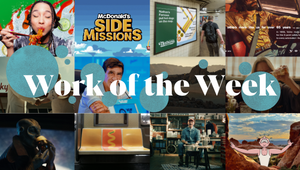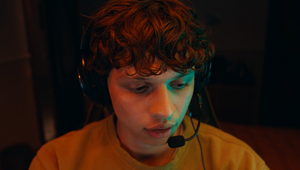
VFX Trends: Making the Impossible Plausible

Suraj ‘Sid’ Harrington-Odedra is an award-winning VFX artist who started his career at The Mill in 2006 where he stayed until 2021. Over the years, he has worked with top-tier commercial talent including DOM&NIC, Taika Waititi, Tom Hooper, Sam Brown, Simon Willows, Ian Pons Jewell and Guy Ritchie.
Sid embraces the technical intricacies of his craft and of creative collaboration. He believes VFX is a team sport, where every artist brings fresh perspectives that elevate the final vision, often leading to exciting, unexpected outcomes.
After gathering an enormous amount of knowledge in commercials, Sid shifted to film and TV for several years, working on large scale shows and Hollywood features for streaming services including Netflix and Apple TV+.
For Sid, the joy of VFX lies in translating directors’ visions from paper to screen. He loves the journey of refining ideas through creative development and continues to push technological boundaries, bringing bold ideas to life, one shot at a time.
LBB> What’s the biggest misconception people have about VFX?
Sid> There's a massive trend across the industry where directors’ treatments use generative AI to create something with high fidelity, but very little finesse. In its early days, this seemed like a godsend for production companies and directors. It was like having a concept artist available to make anything you wanted in seconds. However, I think agencies worry that these generative images, whilst good, won't reflect the final image.
Filmmaking is a collaborative process where people should be allowed to develop an idea over time, find out what works and what doesn't work. Finding the moments that really make a shot or sequence sing requires the input of multiple people and simply can't be produced by a generative AI that doesn't understand the context of a request.
LBB> There are two ends to the VFX spectrum – the invisible post and the big, glossy 'VFX heavy' shots. What are the challenges that come with each of those?
Sid> Doing the glossy projects is what every VFX artist lives for. These are the projects that will come front and centre for brands, agencies, directors and post houses alike. Usually, they will involve fresh challenges and pushing boundaries that will make people talk. And it's exactly this that brands want: to get people talking.
How do you make this happen? It’s crucial for a VFX house to have enough time in preproduction to research and artistically explore a director's ideas and to mix in their own thoughts to really help shots soar.
There's a similar (but different!) sense of satisfaction in making invisible effects. This can range from subtle set extensions done by matte painting artists to fully CG environments that people don’t expect to be hand crafted but were too expansive to be captured in camera.
LBB> As a VFX person, what should directors be aware of to make sure you do the best possible job for them?
Sid> Being involved as early as possible in the production process is crucial. Ensuring that the live action footage for a given VFX shot is captured in the optimal way for the post production process can help to reduce costs and make sure that artists are spending time on what they do best, rather than trying to cobble together the material they need to make a shot work. This early involvement also ensures that the shoot will go smoothly, with no unexpected requests that take up precious time or resources.
LBB> VFX is a true craft in the classic sense of the word. Where did you learn your craft?
Sid> After studying 3D animation at university and attending a short course at Escape Studios, I got my first role as a junior 3D artist at The Mill in 2006. I stayed there until 2021, by which time I had become a visual effects supervisor. This involved working with directors on set and then overseeing all VFX work for a project through to delivery.
Working at The Mill for such a long time meant that I got to work on a very broad range of projects – everything from creatures and complex environment work to personally crafting some VES-nominated simulations for the likes of Wrigley’s and Sky. Working on such varied projects meant that I've had all sorts of curveballs thrown at me, so I have learned to be agile and adapt to difficult circumstances quickly.
LBB> Think about the very, very start of a project. What is your process for that? Do you have a similar starting point for all projects?
Sid> Reference, reference, reference. This is key. You need to understand all aspects of what you're making, how it reacts to light and how you can replicate this in CG. Having this library of reference is great for the director, too, so they know from an early stage exactly what targets you're planning on hitting and whether this matches up with their expectations.
However, there are times when you're having to make something quite fresh and new. In these cases, it may not be possible to find the exact reference images that match your final output. So, I like to try and find a range of different references that feel right for one reason or another, with the goal of combining lots of small details together.
When you're in this position and can't find a great deal of reference, it tends to be a good sign as you know that you're going to make something that is visually fresh and 'new'!
LBB> We imagine that one of the trickiest things with VFX is, time issues aside, deciding when a project is finished! How do you navigate that?
Sid> This is an issue amongst some of the artists that I have had the pleasure of working with! There have been many occasions where we would like another few days to add in some finer details into a shot to really elevate it from being 'great' to 'outstanding'.
I suppose there are some other signs that tell us when a shot is considered 'finished'. First and foremost, I will always ensure that the director and the clients are happy. Then, if I have time, I try to spend some time pleasing the other critics of my work: myself... and my peers! I often think about what some of my friends at other companies would say if I showed them certain shots. What would their critique be? What are some quick things I can do to make them happy?
LBB> Is there a piece of technology or software that's particularly exciting you in VFX? Why?
Sid> I imagine a common answer to this would be artificial intelligence. There are areas of this that are genuinely quite exciting, but there’s a sense of trepidation around the technology amongst the VFX community due to its lack of flexibility and the legal ambiguity of its training data.
At present, most generative AIs tend to be monolithic black boxes capable of turning some words into a picture, which is a magical feat in and of itself. However, I think we're going to start seeing smaller AIs that are essentially tools used by artists in the filmmaking process.
This will mean that there will be artists in the loop, making decisions and ensuring the final output is something that is directable, improvable and able to be iterated without changing too much of the current version.
LBB> And as real time tech and games engines become ever faster and more sophisticated, how do you see that shaping or changing the role of VFX and its place in the production pipeline (e.g. thinking about things like virtual production)?
Sid> Realtime engines have become an incredibly powerful tool in recent years, not just for rapid previzing, but sometimes, for final pixels. The efficiencies gained have changed certain kinds of projects from 'impossible' to 'plausible'. Virtual production has enabled film makers to transport their actors from one side of the Earth to the other, in the blink of an eye, often requiring little to no post production work.
However, this is where I feel like most of the power comes from with real time engines – using them on-set, in real time. Having tinkered with real time engines in post, I feel like they are currently inadequate for most commercial pipelines, whose output needs to be of the highest, most cinematic fidelity possible. When you throw complex objects into the mix – fur, smoke, reflective/refractive objects – using real time engines can sometimes be a game of trade-offs, as they aren't built to handle complexity or accuracy, but instead, are optimised for millisecond frame rendering times. As a result, when you hit a technical ceiling of one of these engines, it's almost impossible to overcome.
Traditional VFX pipelines that involve a combination of Houdini, Arnold and Nuke have been finessed over many, many years to handle the incredible detail and complexity that our work requires of them, so as a result, a talented artist can very quickly churn out high quality renders that real time engines would struggle with. When you throw into the mix the very quick turnaround of commercials work, it makes sense to throw CPUs at the problem instead of another piece of software with a low technical ceiling.
LBB> When you’re watching a VFX-heavy ad or movie, what are the tells that you look for to figure out how well crafted it is?
Sid> Looking out for the intentional imperfections of the models, textures and animations are the biggest giveaways. After this, it's all about how well the live action and VFX elements interact, not just with their movements, but also how well the light interacts with the surfaces. This can largely be down to how much consideration was put in during pre-production, and whilst filming on set.
LBB> What was your first creative milestone in the industry – the project you worked on that you were super proud of?
Sid> After around four years of working at The Mill in London, I was seen to be somewhat of a specialist in simulating and rendering smoke in CG. A project turned up in our Los Angeles office that required making two creatures and an object out of smoke for a Wrigley’s commercial, and I was asked to fly out there for two months to help complete it.
I was utterly thrilled and jumped at the chance. However, on landing in California, the brief had changed, and the director now wanted all the assets to be formed out of liquid. I had never done any liquid simulations before, ever.
After a couple of slightly panicked weeks of learning on-the-job, I had settled on a workflow that would involve a custom coded particle system in Maya which would then be meshed and rendered with Mantra in Houdini, both of which were new to me.
The job went on to be nominated for Best Simulation in a Commercial at The VES Awards, which I was utterly thrilled about.
LBB> From a VFX perspective, which ads have you seen recently that you've been particularly fond of and why?
Sid> ETC's ‘Masterpiece’ commercial for Coca Cola was a beautifully crafted spot. Having to mix many different styles all in one commercial must have been so much fun to experiment with and work on. It was so lovely to see a mixture of 2D and 3D skills being used to bring this spot to life. Hats off to the artists on that team!














